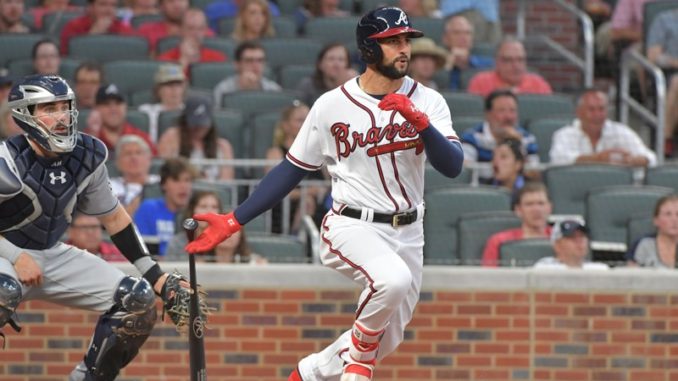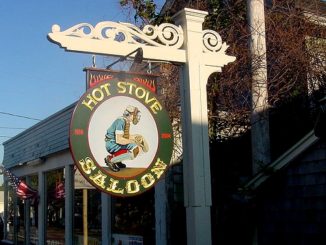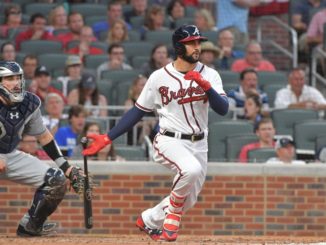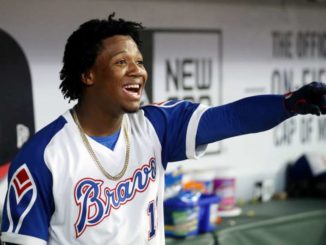
Welcome back to the Hot Stove Report, your semi-regular capsule of all of the off-season news, rumors, transactions, and winter league action for the Atlanta Braves. Check in with us every week through the start of spring training as we sift though everything Braves.
Roster Check-In, Post-Markakis
Last week the Braves welcomed back Nick Markakis on a one-year, $6 million guarantee. After four seasons averaging a little over 1.4 fWAR, the signing represents both good value on the field and continued positive clubhouse presence.
That said, the signing also represents for some fans a sign that the Braves, outside of the Josh Donaldson signing, have added little to the major league roster from last season. With the Nationals, Mets, and Phillies all making flurries of acquisitions over the course of the winter, many fans desire to see the Braves make a big splash themselves.
Before the trade, I was looking at the roster at the time, looking for areas that could be improved. The Braves have players that project to be top-10 in the MLB at first, second, third, and whichever outfield spot that Ronald Acuña plays. At catcher they have a duo that should together keep the Braves in the top 10 in overall value. Centerfield is set with a top-notch defender who could put up a top-10 value season by hitting at established levels (see my recent Braves System Depth 2019: Centerfield piece where I discuss this). On the bench is Johan Camargo, who will likely be starting at least 4 or 5 times a week, Charlie Culberson, and whichever catcher isn’t starting.
The main concerns were the other corner outfield spot and the fourth spot in the bench, which ideally would be an outfielder that could also be the team’s top left-handed pinch hitter. Lucas Duda filled this spot well down the stretch last year, but ideally that player would also be able to play a position.
The Nick Markakis signing does fill that last corner outfield spot, but he’s an even better fit as that left-handed outfield bench player. Obviously $6 million is more than a team would want to spend on a bench bat, but given the amount of insurance and depth having a player like that on the team would bring it’s not too outrageous. In the end, I don’t believe the Braves are completely out of the outfielder market.
Realmuto Hostage Crisis, Week 58
Trade talk between the Miami Marlins and several other teams for All-Star catcher J.T. Realmuto reportedly intensified over the last several days. Shortly after signing outfielder A.J. Pollock early last week, the Dodgers were reportedly pursuing a trade hard. That talk started to fade by the end of the week as the Marlins apparently contacted interested teams with proposals. The most frequently mentioned teams in pursuit if Realmuto as of this writing are the Reds, the Padres, and the Braves.
One thing that has been consistent in all of the Realmuto reporting has been the Marlins desire for a controllable major league or near-major league asset plus other top prospects. The other thing that has been consistent is that all things being equal, the Marlins do not want to trade Realmuto within the NL East. It is likely that for the Braves, the offer to Miami for Realmuto would have to exceed those of other teams.
Non-Roster Invitations
The Braves announced that they were inviting 20 players to big league spring training camp this season.
The list was a mix of veteran minor leaguers such as outfielders Ryan LaMarre and Rafael Ortega who could be called up in case of injuries and top prospects like third baseman Austin Riley and right-hander Ian Anderson.
IF: CJ Alexander, Andres Blanco, Pedro Florimon, Sean Kazmar, Luis Marte, Austin Riley
OF: Greyson Jenista, Ryan LaMarre, Rafael Ortega, Cristian Pache, Drew Waters
C: William Contreras, Carlos Martinez, Jonathan Morales
RHP: Ian Anderson
LHP: Thomas Burrows, Corbin Clouse, Tucker Davidson, Kyle Muller, Joey Wentz
Alexander and Jenista were 2018 draft picks and this is their first professional spring training. This will be the first big league camp for Waters, Martinez, Morales, Anderson, Burrows, Clouse, Davidson, Muller, and Wentz.
Minor League Additions
Since the last Hot Stove Report, the Braves have added three more minor league free agents.
- The Braves added another first baseman in former Rockies prospect Ryan Casteel. Casteel was drafted in the 17th round in 2010 by Colorado and made it as far as the AAA level, splitting time between catching and first base. After a slow start to the 2016 season however, Colorado released Casteel. He was picked up by the Mariners organization, and he played with their AA affiliates for the remainder of 2016 and 2017. Despite hitting a solid .272/.323/.429 in 2017, Casteel didn’t get signed by an affiliated team for 2018 and he ended up playing with the Lancaster Barnstormers of the independent Atlantic League (teammates included former Braves Joey Terdoslavich and Matt Marksberry), where he caught more than 60 games for the first time since 2012. Casteel hit .321/.383/.523 with 16 homers as a Barnstormer. If he makes the squad, look for Casteel in AAA Gwinnett, where having a third catcher is helpful if one of the catchers on the 40-man roster, Alex Jackson or Raffy Lopez, are called up to Atlanta without notice.
- Also signing is 23-year-old Dominican infielder Ariel Montesino who has played his six-year pro career in the Minnesota Twins organization. Montesino only owns a .235/.308/.315 career minor league batting line with 6 home runs but can handle second, third, and short adequately. Montesino finished 2018 at the single-A level, and a return there seems the mostly outcome given Rome’s projected unsettled shortstop situation if A.J. Graffanino graduates from Opening Day or soon thereafter.
- Last but not least, the Braves added 28-year-old right-hander Claudio Custodio. Signed as an infielder out of the Dominican Republic by the New York Yankees, Custodio got some prospect buzz after he hit .325/.433/.414 in the Gulf Coast League in 2011. He made it as far as advanced-A ball before the Yankees pulled the plug on his position player career and converted him to pitching. Going back to the Gulf Coast League, Custodio re-started his career. He became a free agent after the 2016 season after making it back as far as A-ball again, but couldn’t find an affiliated team to sign with. Custodio pitched 2017 with the Intercounty Baseball League in Ontario and drew the attention of the Toronto Blue Jays, who signed him as a free agent for the 2018 season. After pitching well for class-A Lansing in the first half, Custodio spent the second half splitting time between advanced-A Dunedin and AAA Buffalo.
Rumors, News, and Innuendo
- Many fans would love to see the Braves reunite with former closer Craig Kimbrel, but whatever payroll room remains, Alex Anthopoulos doesn’t seem inclined to spend it on a reliever. In an interview last with MLB Network Radio, Anthopoulos indicated that “our payroll, our model, I don’t know that us spending big, elite dollars on a reliever — length, the term and all that — I don’t know that that model works for us.” The Braves currently have right-handers Arodys Vizcaino and Darren O’Day and lefty A.J. Minter set to handle high-leverage situations.
- In that same interview, Anthopoulos confirmed reports that the Braves had engaged the Seattle Mariners on pitchers James Paxton and Edwin Diaz. Paxton ended up going to the Yankees while Diaz ended up going to the Mets.
- According to Anthony Fenech of the Detroit Free Press, outfielder Nick Castellanos has not gotten as much interest as the Tigers were hoping for this offseason, and the team seems likely to carry the slugger into the season. It was reported that the Braves checked in on Castellanos earlier in the off-season, but his poor defensive ability would make for an awkward fit on a National League team.
- The Mariners designated right-hander and former Braves prospect Max Povse for assignment on Sunday to make room for free agent signee Hunter Strickland. Povse was traded along with right-hander Robert Whalen to the Mariners in 2016 for catcher Alex Jackson and left-hander Tyler Pike. The Braves 2014 3rd-round pick got 3.2 major league innings with Seattle in 2017 but couldn’t find his way back in 2018.
- MLB Pipeline released their Top 100 Prospects update this weekend. Eight Braves made the list, with Mike Soroka taking the clubhouse lead at #24. Outfielder Drew Waters landed his first Top 100 mention, coming in at #86.
Mailbag Q&A
Thanks to members of the Outfield Fly Rule Facebook group for questions!
Q: What are the pros and cons of signing Craig Kimbrel? – N. Lyle
A: The pros are pretty easy to see. Kimbrel has been an elite relief pitcher since his major league debut in 2010, and at age 30 he’s not so old as to expect a dramatic drop-off in performance. He would lengthen the bullpen and make it a true asset on the team rather than an area that is projected to be around league average.
The cons relate to whatever contract demands Kimbrel is making. Early reports had Kimbrel looking for a 6-year/$100 million deal that would have eclipsed the 5-year/$86 million deal that the Yankees gave Aroldis Chapman. It doesn’t seem likely at this point that Kimbrel will get either the dollars or the length of contract in this market, but whatever Kimbrel settles on it likely would be far more than the Braves would want to outlay for a player who only throws around 65 innings a season.
Q: Are the Braves going to make a significant trade or signing or are they gonna hold off till the trade deadline? Or have they spent all their gonna spend and Liberty Media is gonna use the remaining money to pay down construction loans? – S. Miller
Those three options actually aren’t mutually exclusive. I believe the Braves will make at least one more significant acquisition before Opening Day which is, as a reminder, still two months away.
Anthopoulos has also indicated that he will reserve some payroll flexibility for in-season acquisitions. This must be done to react to unforeseen events like a key injury or to address an unexpected team weakness.
Finally, there’s no doubt that debt service on the new ballpark and adjoining retail area is a driving factor in the Braves budget. The Braves came close to overstepping MLB mandates on how much debt a team can carry in 2018, a situation that would have incurred significant penalties. While that no longer appears to be a danger, debt will continue to play a role in how much money can be put toward the payroll for a couple of years.
Q: What is our path to winning the division in 2019 if we don’t pick up one major acquisition, say a SP or a bat (say C or OF)? Especially in context of an improving on-paper division.
What one acquisition would most increase our probability of winning the division (not specific player but type of player, like a lefty power corner OF that would slot into a certain spot in the lineup)?
Who might possibly be available (FA or trade) would best fit that role? (I’m fine with a few potential options, just curious.) I’m expecting this will consider contexts like short and long range need in terms of talent and finance…. this is starting to sound more like a full article. – M. Smith
OFR colleague Micah Smith clearly thinks I’m not working hard enough.
If the Braves, and I assume no one else in the division, don’t make any more acquisitions the Braves have a fairly straightforward path to winning the division. Veterans like Freddie Freeman, Josh Donaldson, and Nick Markakis have to stay healthy and produce values close to their most recent healthy seasons. While it is unrealistic to expect every young player to take a step up in production, most of them should. In particular I would expect Ozzie Albies, Ronald Acuna, Dansby Swanson, Sean Newcomb, and A.J. Minter to build off their 2018 seasons. Mike Foltynewicz will have to show that the dramatic strides that he made in 2018 are sustainable and Kevin Gausman will have to show that he’s the pitcher that came over after the deadline trade to Atlanta and not the pitcher that was struggling in Baltimore. Finally, the Braves have to get value from their corps of young pitchers as fifth/sixth starters and bullpen fill-ins.
If all this happens, I don’t think it matters much what the other teams in the division do. The Braves will have a successful season.
As for what acquisition would give the most bang-for-the-buck, as I mention in the Post-Markakis section above, a corner outfielder would be most advantageous. Lefty or righty doesn’t matter as much, but another player with proven offensive ability and can hold his own defensively would be my preference. It would push Markakis to the bench, and give the Braves similar depth as we saw from strong playoff teams like the Dodgers and Red Sox.
The options here are nearly unlimited, starting with the high-priced (Bryce Harper) or the difficult to get (Mitch Haniger). Some other possibilities include Pirates Starling Marte or Corey Dickerson, Tommy Pham of the Rays, Yankees Aaron Hicks or Clint Frazier, one of the several Padre outfielders like Hunter Renfroe, Franmil Reyes, or Wil Myers, a short-term Cincinnati Red like Scooter Gennett or Yasiel Puig, or even a player that could use a change of scenery like the Cardinals’ Dexter Fowler or the Cubs’ Jason Heyward accompanied by lots of cash.
Long term, the Braves have prospects like Cristian Pache, Drew Waters, and Greyson Jenista who will all be playing in the upper minors by the end of the season, as well as third baseman Austin Riley who could convert to the outfield.
Q: Do you think the reason the Braves haven’t made a big move is because of the new people they have brought in? Especially on the “numbers” side of things and they are possibly waiting on their take on players and things?
I don’t believe they are waiting on the new personnel to offer their opinions, but the Braves, like every other team in the majors, have a keen desire to extract as much value as possible for their budget. This really isn’t anything new, but modern metrics and methods of quantifying player output have allowed highly precise valuations.
As exemplified by Moneyball, the baseball revolution in data isn’t about any stat or evaluation method; it’s about economics. It’s about wresting the last bit of bang-for-the-buck. It has been so successful that almost every team has adopted some version of this type of valuation. And in the end, I would rather have the front office of my favorite team make the right moves than the fast moves.
There is a whole other discussion about if major league payrolls are set appropriately, and why teams aren’t offering as many long-term contracts.
Your Moment of Zen
Sadie Grace Gausman 7 lbs 5 ounces!! She has stollen every bit of our hearts! 😍😍😍😍 pic.twitter.com/GWvwTKja97
— Kevin Gausman (@KevinGausman) January 25, 2019
All spelling goes out the window when ya get no sleep 😂😂😂 #BabyBrain #Stollen
— Kevin Gausman (@KevinGausman) January 26, 2019




Leave a Reply